While not all Stanley containers are specifically designed as alcohol flasks, Stanley’s stainless steel vacuum-insulated water bottles can safely and discreetly accommodate moderate amounts of beer, wine, liquor, and other alcoholic drinks for a limited time thanks to their durable materials and leakproofing. However, some precautions are advised.
In this comprehensive guide, we’ll cover the viability of using Stanley bottles for alcoholic beverages, including safety factors, ideal models, duration limits, cleaning, risks, and usage tips for transporting adult drinks responsibly. Let’s see how Stanley’s can secretly stash your spirits.
Is It Safe to Put Alcoholic Beverages in a Stanley Water Bottle?
According to Stanley, their signature food-grade stainless steel water bottles are structurally rugged enough to briefly contain most standard alcoholic beverage varieties, including wine, beer, cider, and distilled liquors.
The main limiting factors are the bottle capacity, alcohol’s degrading effects on some seal materials over time, and dilution of taste for long-term storage. But periodic, short-term concealable transport of adult beverages in a Stanley is considered safe.
As always, exercise responsible consumption. But in terms of container viability, Stanley’s can capably carry your alcoholic drinks.
Can You Store Beer in a Stanley Water Bottle?

Certainly. For temporary transport like a day at the stadium or beach, Stanley’s stainless steel bottles easily keep canned or bottled beer cold and concealed thanks to their excellent insulating properties.
Just avoid extended storage exceeding 24 hours, rinse promptly after use, and don’t expose plastic lid pieces to hot water, which can warp from alcohol. Then beer suits a Stanley growler wonderfully.
For denser stouts or wheat beers that cause foaming, consider a wider mouth Stanley to allow expansion room. But for most tailgating and outing needs, discreetly topping off your Stanley with a cold IPA or lager is just fine.
Will Alcohol Damage the Stanley Water Bottle?
When used periodically and cleaned properly afterward, moderate alcohol concentrations cause minimal degradation to Stanley bottles themselves.
However, higher-proof liquors and extensive long-term alcohol exposure slowly damage lid seals, O-rings, and plastic components over years of use.
The stainless walls themselves remain unscathed by beer, wine, or spirits with routine cleaning. Just expect shorter lid/gasket lifespans with daily long-term alcohol use.
Is There a Specific Stanley Model That’s Ideal for Carrying Different Types of Alcohol?
Vacuum-sealed stainless steel growlers like Stanley’s 64-oz Classic Growler offer ideal boozy beverage transport and concealed drinking.
The huge capacity provides ample storage space for beer, box wine, cocktails, etc. The foam expansion room minimizes mess.
And the steel construction insulates temperatures beautifully for hours of chilled or gently warmed drinking pleasure.
For most covert public imbibing of adult drinks, picking a stainless-steel growler style like Stanley’s 64-oz is your best bet.
What Types of Alcoholic Beverages Can Be Stored in a Stanley Water Bottle?
Here are some common boozy drinks Stanley’s bottles can accommodate:
| Alcoholic Beverage | Stanley Bottle Compatibility | Considerations |
|---|---|---|
| Beer |
|
Choose an appropriate size for your beer type. |
| Wine |
|
Check the bottle size for compatibility. |
| Liquor |
|
Ensure the bottle is clean to avoid flavor transfer. |
| Cocktails |
|
Consider the size needed for mixing and storage. |
| Hard Cider |
|
Choose a bottle with suitable mouth size for carbonated beverages. |
| Champagne |
|
Ensure the bottle is designed to handle carbonation. |
Some other key takeaways when storing alcohol in a Stanley container
- Beer: Either canned or bottled, and draft beer, a larger capacity container helps with foam expansion.
- Wine: There is potentially room for an entire bottle of wine, depending on the Stanley bottle size that you choose. Avoid sweet dessert wine stains.
- Hard Liquor: Works for high-proof liquors as well as spiced rums and flavored vodkas.
- Cocktails: You can premix cocktails for tailgates or events. Extra room is suggested.
- Hard Cider: Carbonation may require a wider mouth for foam.
- Champagne: Look for reinforced options rated for carbonation.
While not a long-term aging solution, Stanley bottles work admirably for transporting and even discreetly serving most standard alcoholic drinks.
Will the Stanley Water Bottle Affect the Taste of the Alcohol?
Thanks to stainless steel’s nonporous, neutral properties, alcoholic beverages stored temporarily in a Stanley bottle do not take on any metallic or foreign tastes from the container.
Provided you promptly wash the bottle after alcohol use and don’t allow residue to linger, a Stanley imparts no flavor.
In fact, many alcohol enthusiasts favor stainless steel growlers over glass because they better maintain pure tastes without breaking or leaching.
For the short-term transport of alcoholic drinks, Stanley preserves flavors beautifully. Just clean thoroughly afterward.
How Long Can You Store Alcohol in a Stanley Water Bottle?
For best results, limit alcohol storage duration to 24 hours or less with a thorough cleaning immediately following use.
Long-term alcohol storage risks corrosion, seal degradation, and gradual flavor dilution. Stanley does advise against alcohol storage exceeding 48 hours.
| Type of Alcohol | Storage Duration |
|---|---|
| Beer | Up to a few days for optimal freshness |
| Wine | Up to 3-5 days for red wine, 5-7 days for white wine |
| Liquor | Indefinitely if properly sealed |
| Cocktails | 1-2 days for best taste and quality |
| Hard Cider | Up to a week for optimal flavor |
| Champagne | 2-3 days for carbonated varieties |
For brief discreet transport like a sporting event, picnic, or hike, Stanley’s insulate beautifully. But utilize other permanent alcohol storage solutions for aging or long-duration needs.
Can You Put Wine in a Stanley Water Bottle?
Definitely. In fact, Stanley’s sturdy leakproof design makes their bottles ideal for transporting full bottles of wine safely.
- Vacuum insulation keeps white and red wines chilled, ideally.
- Larger Stanley’s (64 oz+) easily hold entire bottles of wine.
- Leakproof lids prevent spills in transit. Durable for checked luggage.
- Nonporous stainless steel prevents wine stains or residual odors.
- It is easy to quickly clean up any minor drips after pouring.
So for concealing and chilling wine on the go, a durable Stanley bottle excels beautifully. Just limit the duration to preserve taste.
Can You Put Mixed Drinks in a Stanley Water Bottle?
The generous capacities of Stanley’s vacuum-sealed bottles allow ample room for pre-mixed cocktails, Bloody Marys, margaritas, and similar liquor concoctions.
Consider wider mouth options to allow adding ice cubes, fruit garnishes, stirring, etc.
For carbonated drinks, give extra headspace for foam. Insulation keeps mixtures chilled or gently warmed for hours.
Just exercise caution when transporting slippery stainless steel bottles filled with booze. Tight-sealing lids prevent embarrassing spills!
Can You Put Liquor in a Stanley Water Bottle?
Certainly! Stanley’s stainless steel build holds up admirably to high-proof vodka, rum, tequila, and other spirits.
No leaching or corrosion occurs. The insulating properties maintain liquor at ideal sipping temperatures throughout the day’s adventures.
For quick, convenient shots on the go, the durable, leakproof Stanley can discreetly contain your spirits and mixers safely.
Can You Put Hard Cider in a Stanley Water Bottle?
With ample foam room, Stanley’s vacuum bottles easily keep hard cider crisp, cold, and concealed for picnics and outings.
Consider a wide-mouth option to allow for froth expansion as the carbonation is released.
Chill cider fully before filling your Stanley to maximize insulation duration.
Then enjoy bubbly cider anytime without broadcasting your beverage of choice. Bottoms up!
Can You Put Champagne in a Stanley Water Bottle?
Sparkling wine and Champagne require special care in Stanley bottles due to the sensitivity of carbonation. But shorter-duration transport in a foam-friendly wide-mouth Stanley is definitely doable.
Ensure your particular Stanley bottle model is suitable for carbonation. Pre-chill the bubbly fully before filling. Utilize the Stanley quickly after filling for maximum freshness and effervescence.
The insulation keeps Champagne properly icy; just consume it promptly and avoid vigorous shaking to prevent mess. Cheers!
What Are the Risks of Putting Alcohol in a Stanley Water Bottle?
A few usage considerations to be aware of when occasionally using a Stanley bottle for alcoholic beverages:
- Seal degradation with frequent long-term use
- Potential liquor stains on plastic lid parts
- Carbonation leakage with insufficient headspace
- High-proof alcohols could tarnish stainless steel over time
- Dilution of taste with extended aging
- Cracking from thermal shock if filled with hot liquor
With moderation and prompt cleaning, Stanley’s accommodates alcohol beautifully. Just limit the frequency and duration.
How Do You Clean a Stanley Water Bottle After Storing Alcohol in It?
After each alcohol use:
- Rinse thoroughly with clean water
- Wash by hand with mild detergent
- Allow to fully air dry upside down
- Consider occasional sanitizing rinses
- Watch for degraded gaskets or lid stains over time
Proper prompt cleaning prevents any lasting flavors, stains, or corrosion issues when using Stanley bottles for adult beverages in moderation.
In Closing
With their durable stainless steel build, generous capacities, and leakproof seals, Stanley’s iconic vacuum-sealed water bottles can discreetly contain moderate amounts of beer, wine, liquor, and other alcoholic beverages temporarily for responsible transport and consumption. Just beware of long-term aging effects, clean thoroughly after each use, and imbibe safely. Then your trusty Stanley can tag along for all of life’s adventures, adult or otherwise!

About Me
I’m Paul Burkhardt, an expert in water and water treatment since 2006 with in-depth experience not only in treating water but also in helping to provide people with healthier, high-quality drinking water.
I’ve helped thousands of people with their drinking water questions, including what kind of water bottle might be best for them and their lifestyle.
If you’d like more information about me, please check out the links below or read more here:

